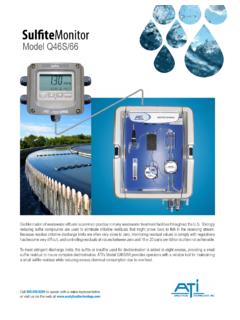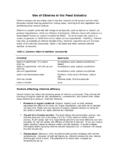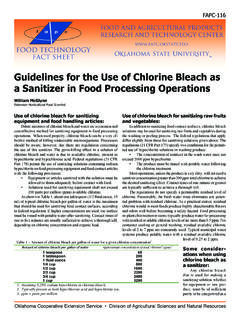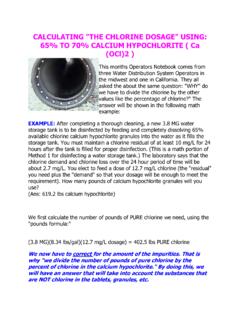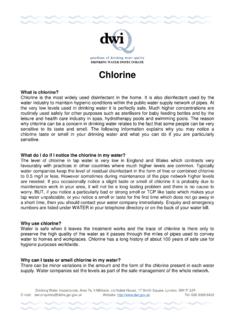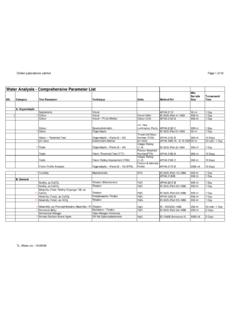Transcription of 11 - How to measure chlorine residual - WHO | World Health ...
1 1 WHO Technical Notes for EmergenciesTechnical Note No. 11 Draft revised: to measurechlorine residual in waterWorld Health OrganizationThe importance of chlorinein waterMany of the most common diseases found intraumatized communities after a disaster oremergency are related to drinking contaminated contamination can be from micro-organisms (Table1) or natural and man made chemicals (Table 2). Thisfact sheet concentrates on the problems caused bydrinking water contaminated by micro-organisms asthese are by far the most common and can bereduced by chlorination. Chemical contamination isdifficult to remove and requires specialist knowledgeand who live in the same place all their lives andregularly drink contaminated water may develop someresistance to the contaminants and suffer little or nohealth problems. Communities affected by anemergency, however, are very different.
2 Emergencieshave three relevant effects on people, they: force people to move to new places where thewater quality is different from what they usuallydrink and for which they have no immunity; force people to live in poor conditions such astents or temporary buildings which make itdifficult to retain good hygiene practices; and they affect their diet, often lowering their nutritionallevel and making them more vulnerable is important, therefore, that all people affected by anemergency are provided with water of a high are a number of ways of improving the quality ofdrinking water. The most common are sedimentationand filtration followed by disinfection. (These arediscussed in other notes in this series). Disinfection(the killing of harmful organisms) can be achieved in anumber of ways but the most common is through theaddition of chlorine . chlorine will only work correctly,however, if the water is clear (Box 1).
3 Table 2. Some chemical contaminants ofdrinking water that may be a danger to healthArsenicCadmiumChromiumCyanideFluor ideLeadMercury*Contaminated water is not the only cause of these diseases; water quantity, poorsanitation and poor hygiene practices also play a roleDiarrhoea*Typhoid*Hepatitis*Cholera* Table 1. Diseases related to drinking watercontaminated with micro-organismsBox chlorine killsWhen chlorine is added, it purifies the water bydestroying the cell structure of organisms,thereby killing them. The process only works,however, if the chlorine comes into direct contactwith the organisms. If the water contains silt, thebacteria can hide inside it and not be reached bythe takes time to kill all the organisms. Inwater above about 18oC the chlorine should be incontact with the water for at least 30 minutes. If thewater is colder then the contact time must is normal, therefore, to add chlorine to water asit enters a storage tank or a long delivery pipelineto give the chemical time to react with the waterbefore it reaches the effectiveness of chlorine is also affected bythe pH (acidity) of the water.
4 Chlorination is noteffective if the pH is above or below Technical Notes for EmergenciesDraft revised: Technical Note No. 11 chlorine residualChlorine is a relatively cheap and readily availablechemical that, when dissolved in clear water in sufficientquantities, will destroy most disease causing organismswithout being a danger to people. The chlorine ,however, is used up as organisms are destroyed. Ifenough chlorine is added, there will be some left in thewater after all the organisms have been destroyed,this is called free chlorine . (Figure 1) Free chlorine willremain in the water until it is either lost to the outsideworld or used up destroying new , if we test water and find that there is stillsome free chlorine left, it proves that most dangerousorganisms in the water have been removed and it issafe to drink. We call this measuring the the chlorine residual in a water supply is asimple but important method of checking that the waterthat is being delivered is safe to drinkWhen and where to test waterThe most common place to use chlorine as adisinfectant is in a piped water supply.
5 Regularchlorination of other water supplies is difficult andusually reserved for disinfection after repair andmaintenance. The chlorine residual is usually tested atthe following points: Just after the chlorine has been added to thewater to check that the chlorination process isworking. At the outlet of the consumer nearest to thechlorination point to check that residual chlorinelevels are within acceptable levels (between mg/l). At the furthest points in the network where residualchlorine levels are likely to be at there lowest. Ifchlorine levels are found to be below mg/l itmight be necessary to add more chlorine at anintermediate point in the amount of chlorine residual changes during the dayand night. Assuming the pipe network is under pressureall the time (see Box 2, overleaf) there will tend to bemore residual chlorine in the system during the daythan at night.
6 This is because the water stays in thesystem for longer at night (when demand is lower) andso there is more opportunity for the water to becontaminated which will use up the residual residual should be checked regularly. If thesystem is new or has been rehabilitated then checkdaily until you are sure that the chlorination process isworking properly. After that, check at least once for chlorine residualThe most common test is the dpd (diethylparaphenylene diamine) indicator test, using acomparator. This test is the quickest and simplestmethod for testing chlorine this test, a tablet reagent is added to a sample ofwater, colouring it red. The strength of colour ismeasured against standard colours on a chart todetermine the chlorine concentration. The stronger thecolour, the higher the concentration of chlorine in kits for analysing the chlorine residual inwater, such as the one illustrated in Figure 2, areavailable commercially.
7 The kits are small : All forms of chlorine are harmful tohealth. Avoid skin contact and do not inhale thefumes. chlorine should always be stored incool, dark, dry and sealed containers and out ofreach of 1. Effect of chlorine mg/lChlorine mg/lWater requires chlorine to destroyall organismsWater notdisinfectedAll organismsdestroyed and residualchlorine remainingAll organismsdestroyed but nochlorine left forfuture contaminationHow to measure chlorine residual3 WHO Technical Notes for EmergenciesTechnical Note No. 11 Draft revised: 1. Place one tablet in the test chamber (a)and add a few drops of the chlorinated watersupply under 2. Step 2. Step 2. Step 2. Step 2. Crush the tablet, then fill chamber (a)with the chlorinated water supply under 3. Place more of the same water supplyunder test (without a tablet) in the secondchamber (b).
8 This is the blank control for 4. Step 4. Step 4. Step 4. Step 4. The level of residual chlorine (R) in mg ofchlorine per litre of water (mg/l) is determined bycomparing the colour of the water supply undertest in chamber (a) with the tablet added with thestandard colours on the vessel (chamber (b)).Note: Chamber (c) would be used if a higherchlorine residual is to be to measure chlorine residualFigure 2. Steps in determining the chlorine residual in water using a comparator4 WHO Technical Notes for EmergenciesDraft revised: Technical Note No. 11 Further informationWHO (2004) Guidelines for drinking water quality, 3rd ed., WHO, and intermittent suppliesThere is no point in chlorinating pipe networks if thewater supply is intermittent. All pipe systems leakand when the water supply in switched off, thepressure will drop and contaminated water will enterthe pipes through the breaks in the pipe wall.
9 Nolevel of residual chlorine acceptable to consumerswill be able to deal with such high levels ofcontamination. All intermittent water supplies shouldbe assumed to be contaminated and measurestaken to disinfect it at the point of information has been prepared by WEDCA uthor and Series Editor: Bob Reed Design: Glenda McMahon Illustrations: Rod Shaw Graphics: Ken ChattertonWater, Engineering and Development Centre, Loughborough University, Leicestershire, : +44 1509 222885 Fax: +44 1509 211079 E-mail: Website: to measure chlorine residualWorld Health OrganizationWHO HeadquartersAvenue Appia 201211 Geneva 27 SwitzerlandTelephone: (+ 41 22) 791 21 11 Facsimile: (+ 41 22) 791 31 11 Telex:415 416 Telegraph: UNISANTE GENEVAA chlorination checklist chlorine needs at least half an hour contact time with water to disinfect it.
10 The best time to apply it isafter any other treatment process, and before storage and use. Never apply chlorine before slow sand filtration or any other biological process, as the chlorine will killoff the bacteria which assist treatment, making the treatment ineffective. Never add any solid form of chlorine directly to a water supply, as it will not mix and dissolve. Alwaysmake up as a paste first, mixing the chlorine compound with a little water. Disinfection is only one defence against disease. Every effort should be made to protect water sourcesfrom contamination, and to prevent subsequent contamination during collection and storage. The correct procedure for applying a disinfectant to water should be strictly adhered to, and watersupplies should be monitored regularly to ensure that they are free from bacteria. Otherwise, peoplemay be misled to believe that the water is safe to drink when, in fact, it is hazardous to do so.











